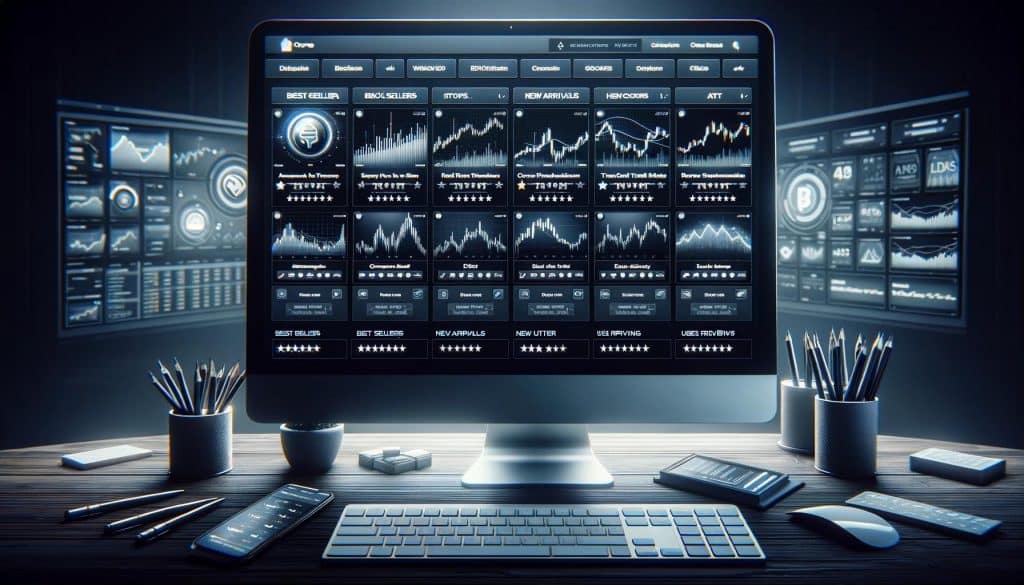In an era where financial markets are more accessible than ever, the concept of building a diversified portfolio through automated trading systems has become a beacon for investors looking to navigate the complexities of various asset classes. This comprehensive guide delves into how automated trading can be a pivotal tool in crafting a portfolio that not only withstands market volatilities but thrives in them, illustrating the synergy between technology and investment strategy.
Introduction to Building a Diversified Portfolio with Automated Trading
The essence of a diversified portfolio lies in its ability to mitigate risks associated with the investment in a single asset class. By spreading investments across a variety of asset classes, geographical regions, and sectors, investors can reduce the impact of a poor performance in any single investment on their overall portfolio. Automated trading systems, powered by sophisticated algorithms, enhance this strategy by executing trades based on predefined criteria, ensuring a disciplined approach to diversification.
The Basics of Building a Diversified Portfolio
The foundational principle of building a diversified portfolio is to invest in a mix of asset classes such as stocks, bonds, real estate, and commodities. The ideal mix depends on an individual’s financial goals, risk tolerance, and investment horizon. For instance, a young investor with a high-risk tolerance and a long-term investment horizon might lean more towards stocks for higher growth potential.
Automated Trading’s Role in Building a Diversified Portfolio
Automated trading systems simplify the execution of a diversified investment strategy by allowing investors to set parameters that automatically adjust their portfolio’s asset allocation based on market conditions. For example, an automated system could be programmed to reduce exposure to stocks and increase holdings in bonds if market volatility exceeds a certain threshold.

Understanding Automated Trading for Building a Diversified Portfolio
Automated trading systems are as varied as the markets they operate in, each designed to meet specific investment strategies and goals.
Key Components for Building a Diversified Portfolio Using Automated Systems
A successful automated trading system for portfolio diversification includes a robust algorithm capable of market analysis, execution of trades at optimal times, and real-time adjustment of strategies based on market dynamics. Such a system might use technical analysis, fundamental analysis, or a combination of both to make trading decisions.
Types of Automated Trading Systems for Diversification
Automated trading systems range from simple setups, like moving average crossover systems, to complex strategies employing machine learning to predict market trends. For example, a system could use an algorithm based on the Relative Strength Index (RSI) to identify overbought or oversold conditions in various markets, signaling when to buy or sell as part of a diversification strategy.
The Strategy Behind Building a Diversified Portfolio
Effective diversification requires not just a broad range of investments but a strategic approach to balancing them.
Asset Allocation: The Foundation of Building a Diversified Portfolio
Asset allocation involves determining the right mix of asset classes based on the investor’s risk tolerance, investment objectives, and time horizon. An automated trading system can dynamically adjust this allocation in response to market conditions, maintaining the desired balance. For instance, during a market downturn, the system might automatically shift assets from stocks to more stable investments like bonds or gold.
Leveraging Automated Trading to Enhance Portfolio Diversification
Automated trading can execute diversification strategies that are beyond the capabilities of most individual investors due to the complexity or time required to manage them manually. For instance, it can implement a strategy that diversifies not just across asset classes but also across different trading strategies, such as momentum trading and mean reversion, to spread risk even further.
Implementing Automated Trading in Building a Diversified Portfolio
Putting automated trading to work in building a diversified portfolio involves several steps, from strategy formulation to continuous monitoring.
Strategic Approaches to Building a Diversified Portfolio
Diversification strategies might include sector rotation, where the automated system shifts investments among sectors expected to outperform the market. Another strategy could involve geographic diversification, where investments are spread across global markets to mitigate the risk of a downturn in any single region.
Real-World Examples of Building a Diversified Portfolio Through Automation
Consider an automated trading strategy that diversifies across various currencies and commodities in addition to stocks and bonds. By automatically adjusting allocations based on changes in currency values and commodity prices, the system can capitalize on opportunities that would be difficult for individual investors to identify and act upon manually.

Risk Management in Building a Diversified Portfolio with Automated Trading
Risk management is integral to the success of any investment strategy, particularly when using automated systems.
Identifying and Managing Risks in a Diversified Portfolio
Automated trading systems can be programmed with risk management protocols such as stop-loss orders, which automatically sell an asset when its price falls to a certain level, protecting the portfolio from significant losses.
Protective Measures for Your Diversified Portfolio Using Automated Trading
For instance, an automated system could be set up to automatically rebalance the portfolio if the volatility of a specific asset class exceeds predetermined levels, thereby maintaining the portfolio’s overall risk profile.
Optimization Techniques for a Diversified Portfolio Using Automated Trading
Continuous optimization is crucial to ensuring that an automated trading strategy remains effective and aligned with investment goals.
Evaluating and Adjusting Strategies for a Diversified Portfolio
Regular backtesting against historical market data allows investors to evaluate the effectiveness of their automated trading strategies and make necessary adjustments. This iterative process helps in refining the algorithms to better respond to future market conditions.
Balancing Risk and Reward in a Diversified Portfolio through Automated Trading
An advanced automated trading system might use predictive analytics to adjust the risk level of the portfolio in anticipation of market movements, thereby optimizing the balance between risk and reward based on the investor’s risk appetite.

The Future of Automated Trading in Building a Diversified Portfolio
The future of building a diversified portfolio with automated trading systems looks promising, with advancements in technology offering new ways to analyze data and make investment decisions.
Emerging Technologies and Their Impact on Diversification
Technological advancements, such as artificial intelligence and big data analytics, are making automated trading systems more sophisticated. These systems are capable of analyzing vast amounts of data to identify patterns and trends that humans might miss, allowing for more nuanced and effective diversification strategies.
Adaptive Strategies for a Future-Proof Diversified Portfolio
Future automated trading systems will likely be even more adaptive, capable of learning from market changes and adjusting diversification strategies in real-time to protect against losses and capitalize on opportunities.
Conclusion
Building a diversified portfolio with automated trading systems represents a confluence of strategy, technology, and risk management. By leveraging automated trading, investors can implement complex diversification strategies that would be challenging to manage manually, enhancing their ability to achieve long-term financial goals. As technology continues to evolve, the potential for automated systems to refine and execute portfolio diversification strategies will only increase, offering investors powerful tools to navigate the complexities of the global financial markets.

FAQs on Building a Diversified Portfolio with Automated Trading Systems
How can beginners start with automated trading for diversification?
Beginners interested in using automated trading for diversification should start by educating themselves on the basics of the stock market, trading principles, and how automated systems work. It’s advisable to begin with a demo account on a reputable trading platform to practice without financial risk. Selecting user-friendly software with strong community support and educational resources can also ease the learning curve. Finally, starting with simple strategies that focus on diversification across different asset classes can help beginners avoid common pitfalls.
What are the key risks associated with automated trading, and how can they be mitigated?
The key risks of automated trading include system failure, over-optimization (curve fitting), and lack of market adaptability. To mitigate these risks, traders should ensure they have a reliable internet connection and a backup system in place. It’s crucial to backtest strategies using historical data to avoid over-optimization and ensure the strategy is robust across different market conditions. Diversifying trading strategies and maintaining oversight over automated trades can also reduce risk.
Can automated trading systems adapt to sudden market changes effectively?
Automated trading systems can be designed to adapt to sudden market changes if they include dynamic rules that adjust to volatility or market sentiment indicators. Incorporating machine learning algorithms can also enhance a system’s adaptability by enabling it to learn from new data and adjust its trading parameters accordingly. However, the effectiveness of these adaptations depends on the quality of the system’s design and the accuracy of its predictive models.
How important is software selection in automated trading for diversification?
Selecting the right software is crucial in automated trading for diversification because the software’s capabilities determine the complexity and effectiveness of the strategies that can be implemented. Important features to look for include the ability to trade across multiple asset classes, backtesting capabilities, access to real-time market data, and the flexibility to customize or program trading algorithms. A platform that supports a wide range of assets and offers robust analytical tools can significantly enhance a trader’s ability to diversify effectively.
What are some common mistakes to avoid in automated trading for portfolio diversification?
Common mistakes include over-reliance on backtesting results without considering forward performance, using overly complex strategies without fully understanding them, neglecting transaction costs in trading strategies, and failing to continuously monitor and adjust strategies as market conditions change. To avoid these pitfalls, traders should emphasize realistic backtesting, simplicity, ongoing strategy evaluation, and risk management.
How does the regulatory environment impact automated trading strategies?
The regulatory environment can significantly impact automated trading strategies, as regulations may dictate the types of strategies that can be employed, the markets in which one can trade, and the level of transparency required. Compliance with financial regulations is crucial to avoid legal issues. Traders should stay informed about regulatory changes in their markets and adjust their strategies accordingly to remain compliant.





